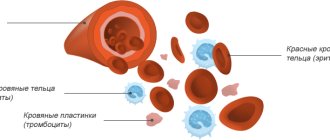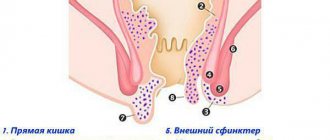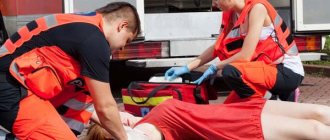Issues regarding bleeding will never lose their relevance. After all, no matter how medicine learns to deal with them, there will still be unresolved issues in some cases. This is especially important in relation to massive blood loss, in which it is extremely important to instantly recognize specific types of bleeding, which will allow the correct assistance to be provided. And although, at first glance, there is nothing complicated about this, even experienced doctors in some critical situations can make mistakes, getting lost at the sight of a large amount of blood. Therefore, every person is obliged to know what a specific type of bleeding looks like, and what extent of measures should be provided in this case.
General classification
The division of bleeding into different types is of great expediency due to the ease of determining treatment tactics at different stages of medical care. Wherever she finds herself, all doctors know her clear algorithm. This approach minimizes the time spent and minimizes the amount of blood loss. People who are not involved in medicine should also know the main features and possible types of bleeding in order to help themselves or their loved ones if necessary.
The classification is given in table form.
| External bleeding (bleeding with direct contact with the external environment) | Internal bleeding (the spilled blood does not have direct contact with the environment) |
|
|
| According to the amount of blood loss during any bleeding | |
| |
Further treatment
Combined methods are mainly used.
First of all, it is necessary to eradicate the source of the disorder. This problem is solved by surgical intervention methods.
The vessel and tissues are sutured, and the damaged area is eliminated (if necessary, doctors perform a resection and remove part of the altered structures). Mandatory measures are also taken regarding the consequences of the pathological process.
In parallel, transfusion is necessary to restore lost blood volume and the introduction of saline solutions to correct the balance of electrolytes. The patient's condition is constantly monitored in a hospital setting.
Capillary bleeding
The most common type of external bleeding is capillary. They occur with any traumatic injury that disrupts the integrity of the skin. They manifest themselves as a low-intensity, uniform flow of blood from the wound due to damage to the capillaries (the smallest vessels of the body). They rarely lead to severe blood loss, since in most cases they stop on their own. They present no difficulties either for diagnosis or for treatment. The exception is extensive superficial wounds, in which prolonged neglect of medical care can cause large blood loss.
Prohibited actions
What you should absolutely not do:
- Give enemas.
- Give any medications. It is not safe. The use of medications is impossible; a sharp deterioration in the condition is likely.
- Under no circumstances should you heat the affected area. This will lead to the dilation of blood vessels and will cause a sharp increase in the intensity of the outpouring of liquid connective tissue.
- Also, you should not move the patient again, so as not to provoke increased bleeding.
Attention:
Self-action in such a serious situation is the best way to ensure death for the patient. Everything must be within the minimums described above.
Venous bleeding
Venous bleeding occurs with superficial and deep wounds of any size, in which the integrity of the saphenous or intermuscular veins is disrupted. In this case, quite intense bleeding occurs. The following symptoms can clinically recognize venous bleeding:
- Dark blood;
- The bleeding is very heavy, like a constant flow of blood from the wound;
- It decreases when the area below the wound is pressed.
Venous bleeding is extremely dangerous if medical assistance is not provided in a timely manner. In this case, massive blood loss occurs in a short time, up to a state of shock. They rarely stop on their own, so stopping them should not be neglected. Superficial veins bleed less intensely, while damage to deep veins causes profuse bleeding.
Differences between arterial (a) and venous (b) bleeding
Forecast
Controversial. Depends on the situation. There are two main factors. This is the degree of the disorder (its severity), as well as the moment of initiation of therapy. With timely treatment, if the disorder is relatively harmless, there is every chance of full recovery.
Internal bleeding is a life-threatening process that is not always obvious at first glance. Without proper correction, it is often fatal.
Specialists eliminate the causes of the anomaly using surgical methods. Medication methods are also used. The forecasts remain vague. When assessing prospects, you need to proceed from the situation.
Arterial bleeding
Given the deep location of the arteries in the tissues, their damage is the least common. The most common causes are knife, gunshot and mine-explosive wounds. In everyday life, these can be puncture wounds from thin and narrow objects. Clinically, arterial bleeding can be suspected by the following signs:
- Bright red blood;
- Flows out in the form of a pulsating stream;
- Very intense;
- Does not decrease with normal pressure on the wound or tissues above and below it;
- The localization of the wound corresponds to the projection of the course of large arteries.
Typically, arterial bleeding is very intense and quickly leads to massive blood loss and shock. If a complete rupture of an artery occurs, then in just one minute you can lose almost the entire volume of circulating blood. Therefore, such bleeding requires immediate assistance.
Wound tamponade
Emergency care for a person with bleeding in the head or neck area, when a tourniquet cannot be applied, is to pack the wound. To do this, use a sterile bandage or cotton wool; if you don’t have them at hand, you can take napkins. The tampon is pressed tightly to the wound site and a bandage is applied. The bandage should be made tight to avoid blood leakage. This method can be used in case of damage to the vessels of the upper and lower extremities. To do this, the wounded arm or leg must be raised to drain the blood, a tampon placed in the area of the affected artery, and a tight bandage applied to secure it.
Important! Despite the fact that the methods described above are only temporary help for the patient, and the patient still requires treatment in the hospital, clear actions of the helper can save a person’s life.
Internal bleeding
Unlike external bleeding, in which it is impossible not to notice their symptoms, internal bleeding is more insidious. After all, recognizing them is not so easy. They usually manifest themselves when there is already quite a lot of blood loss. Therefore, it is extremely important to know all the possible signs of this dangerous condition. These include:
- General weakness and drowsiness;
- Discomfort or pain in the abdomen;
- Unmotivated decrease in blood pressure;
- Frequent pulse;
- Pale skin;
- The appearance of pain in one of the halves of the neck, which occurs in a horizontal position and decreases in a vertical position (Vanka-Vstanka’s symptom).
The occurrence of internal bleeding is preceded by closed or penetrating wounds of the abdomen, lower back, rib fractures, stab or gunshot injuries. In this case, damage to internal organs occurs, which causes a violation of the integrity of blood vessels and bleeding. The result is an accumulation of blood in the abdominal cavity, chest, and saturation of the damaged organ or visceral fatty tissue (hematoma).
Such bleeding can progress at lightning speed, but can also increase over several days after the injury. It all depends on their intensity and the extent of damage to the injured organ. Usually the spleen is affected, less often the liver. With a one-stage rupture, bleeding occurs immediately; with a two-stage rupture, an intraorgan hematoma first appears, which ruptures after a few days, causing an immediate worsening of the patient’s condition.
Causes
There are many main provoking factors. It is worth mentioning only the most common ones. In generalized form, the list is represented by the following points:
- Mechanical factors. Injuries, physical damage.
- Infectious pathologies in which a purulent process is observed. As a result, a melting of arteries, veins, and capillaries develops.
- Effect of ionizing radiation on tissue. Rarely seen. As a result of man-made disasters, inadequate selection of dosage during radiotherapy.
- Natural processes that affect the body in a negative way. There are more of them than might seem at first glance. This includes, for example, pregnancy, difficult childbirth in women, and intense physical activity.
- Vascular diseases. Increased fragility as a result of vitamin C deficiency is a classic case.
- Pathologies of the hematopoietic system. Hemophilia, problems with the synthesis of coagulation factors (thrombocytopenia), myeloproliferative disorders.
- Thrombocytopathies of various types. Platelet synthesis is normal, but they are not complete and do not clot blood effectively.
- Chemical hazards. Poisoning with certain substances. Vapors of acids, alkalis and other components. Especially often, as a result, pulmonary bleeding develops with the release of pink, foamy sputum.
- Destructive pathological processes. Cancerous tumors of any location with infiltrative growth and decay. Also tuberculosis, syphilis in the advanced phase, etc.
- Rupture of aneurysms of any vessels. In the case of the aorta, death occurs within 3-5 minutes.
The causes of bleeding can be mechanical or organic; depending on the situation, each specific factor creates certain risks.
Gastrointestinal bleeding
If you understand thoroughly, this type of bleeding cannot be classified unambiguously. After all, blood flows into the lumen of the gastrointestinal tract, but at the same time it comes into contact with air. But this is not as important as detecting the symptoms of such a condition. After all, the patient’s life sometimes depends on timeliness. Signs of gastrointestinal bleeding include:
- General weakness and dizziness;
- Frequent pulse and low blood pressure;
- Pale skin;
- Vomiting blood or brown matter;
- Thin, bloody or thick black stool.
Gastrointestinal bleeding occurs with peptic ulcers, tumor diseases, various necrotic processes in the mucous membrane of the digestive tract and some other diseases. Therefore, people with such a pathology must be aware of the possibility of bleeding and, if they occur, be sure to seek medical help.
Educational video on first aid for bleeding:
Pressure of arteries
In order not to get confused in case of bleeding and quickly find a suitable place to press the vessel, you should remember the following points of the body.
- Inguinal fold – in case of leakage from the thigh vessel.
- Popliteal region - with bleeding from the artery of the leg.
- The axillary region, the inner side of the biceps muscle - for the damaged arm vessel.
- The area on the neck (inner edge of the sternoclavicular muscle) - when flowing from the carotid artery.
- Supraclavicular surface - to stop bleeding from the subclavian vessel.
What to do if you are bleeding
Therapeutic tactics must be differentiated and depend on the specific type of bleeding. There is a general scope of activities that must be carried out in any type. All specific manipulations are purposeful, since their incorrect implementation can cause harm to the patient. General measures to help with bleeding include:
- Place the victim in a horizontal position;
- Monitor consciousness, pulse and blood pressure;
- Rinse the bleeding wound with hydrogen peroxide and apply a clean pressure bandage;
- If possible, apply ice to the source of bleeding;
- Transport the patient to the nearest facility.
The listed measures will never harm, regardless of the source and characteristics of the bleeding.
Differentiated tactics are presented in table form.
| Type of bleeding | Scope of necessary activities | |
| First aid (temporary stop of bleeding) | Specialized medical care (final stop of bleeding) | |
| Capillary |
| Stitching the wound if necessary. |
| Venous |
|
|
| Arterial |
| Suturing or prosthetic replacement of the damaged artery with further suturing of the wound. |
| Internal and gastrointestinal bleeding | General measures for bleeding, typical for the prehospital stage. |
|
Rules for applying a tourniquet
A tourniquet should be applied exclusively for arterial bleeding. Its erroneous use for venous bleeding will lead to their intensification. Characteristics of correct application of a tourniquet:
- It is applied to the affected segment no lower than 20 cm from the wound. It can be higher. A lower location is permissible only if it is impossible to perform the classic manual;
- A fabric bandage is placed on the skin under the tourniquet;
- A special hemostatic tourniquet or improvised materials that replace it can be used as a tourniquet;
- The first circular tours of the tourniquet around the limb are less tight. After them, tighter tours should be applied;
- After a properly applied tourniquet, bleeding decreases. If this does not happen, this indicates either that it was applied incorrectly or that there is no indication for this;
- The permissible duration of holding the tourniquet on a limb should not exceed 2 hours in the summer and 1-1.5 hours in the winter;
- If it is impossible to apply a tourniquet (neck wounds, high wounds of the shoulder and thigh), it is replaced by other methods of stopping bleeding: external digital pressure on the pulsating vessel above the wound or directly in it.
Correct application of a tourniquet as one of the ways to stop arterial bleeding
Only strict adherence to algorithms for determining the type of bleeding and step-by-step implementation of therapeutic measures can really effectively help in the fight against this problem. Remember the general rules and then you can protect yourself and your loved ones from dangerous complications of any bleeding.
Instructions for performing digital compression of the wound
The actions of the person providing assistance must be quick and concentrated. You must not panic, you must concentrate and strictly follow the following instructions:
- if the exact location of the wound is not clear, it should be pressed with your palms, this will help determine the source of bleeding;
- if necessary, remove clothing by tearing it or cutting it with scissors;
- It is recommended to squeeze the artery with your thumb or covering hand;
- You cannot remove your hand until the victim is bandaged;
- If you hold your fingers for a long time, cramps and numbness may develop; in such a situation, you should replace it with the other hand.
If the situation allows, before squeezing the wound with your fingers, it is recommended to wash them with soap or treat them with an antiseptic, this will avoid infection of the wound and the development of complications. This advice does not apply to situations where the main arteries are damaged and minutes are counting.
Symptoms
At the very beginning, the symptoms are vague, which makes this condition similar to various diseases. Doctors say that there are general symptoms that are characteristic of each type of blood fluid loss, while there are also certain signs that indicate a specific problem.
General symptoms of blood loss
Common signs of internal bleeding are:
- Dizziness.
- Nausea.
- Vomit.
- Fainting.
- Weakness.
- Cold sweating.
- The skin and whites of the eyes become pale.
- Apathy, I want to sleep, it is impossible to concentrate.
- Coma.
- Clouding of consciousness, a person reacts inadequately to everything that happens around him. This condition occurs in very severe cases.
You can recognize which vessel was injured:
- Capillaries – weak abundance of blood fluid.
- Capillaries from a parenchymal organ - profuse, prolonged bleeding.
- Artery - blood has a bright, red color, and the process itself is jerky.
- Vein - blood flows out smoothly, evenly, it has a dark color.
In addition, general symptoms in a child and an adult may depend on the severity of the loss of blood fluid:
- Minor – pulse increases slightly, blood pressure decreases.
- Medium – there is a drop in systolic pressure to 80 mm. rt. Art., increased heart rate, cold extremities, sometimes there is a slow reaction.
- Severe case - systolic pressure is less than 80 mm. rt. st, the respiratory rhythm is disturbed, sticky sweating appears, trembling in the hands, darkening in the eyes, thirst, apathy.
- Massive blood loss - blood pressure decreases greatly, the pulse quickens, consciousness becomes confused, delirium appears, the eyes become sunken.
- Fatal hemorrhage - coma ensues.
Signs of hemothorax
The manifestation of hemothorax is influenced by the degree of blood loss, compression of the lung tissue, as well as shift of the mediastinal organs. Small hemothorax is characterized by minimal or no symptoms. Doctors include moderate shortness of breath and pain in the sternum, which intensifies during coughing, as the main complaints. As for medium and large hemothorax, in such conditions respiratory and cardiovascular disorders are observed; during breathing and coughing, pain from the chest moves to the back and shoulder. The patient also feels weak, his blood pressure decreases, and tachypnea occurs. Severe hemothorax is characterized by fainting, pale skin, weakness, dizziness, and cold sweat.
According to medical statistics, 3-12% of patients develop a coagulated hemothorax. In this case, blood clots and fibrin layers form in the pleural cavity, which interferes with the respiratory function of the lung, this in turn gives impetus to the onset of sclerotic processes that affect the lung tissue. The clinical picture of such hemothorax is manifested by shortness of breath, heaviness and pain in the chest.
Signs of uterine bleeding
Distinctive symptoms of bleeding from the uterus in women are the release of blood fluid from the vagina, the appearance of a large volume of blood clots during menstruation, prolonged menstruation up to 7-8 days, and blood is observed after sexual intercourse. Otherwise, uterine bleeding may have signs that are common to internal blood loss of any kind.
Signs of hemorrhage in the urinary and digestive organs
Many people are interested in how to determine internal bleeding of the esophagus and urination. The following may indicate this condition:
- The stool takes on the color of tar and has a foul odor - the intestines and digestive organs are damaged.
- Vomiting has bloody clots or becomes like a coffee mass - the stomach or duodenum is affected, respectively.
- Bright blood from the anus - the hemorrhoids were damaged.
- Blood in the urine - the kidney area and urinary tract are affected.










